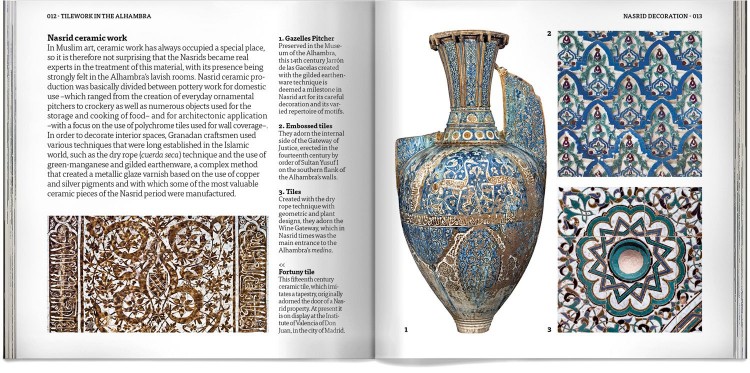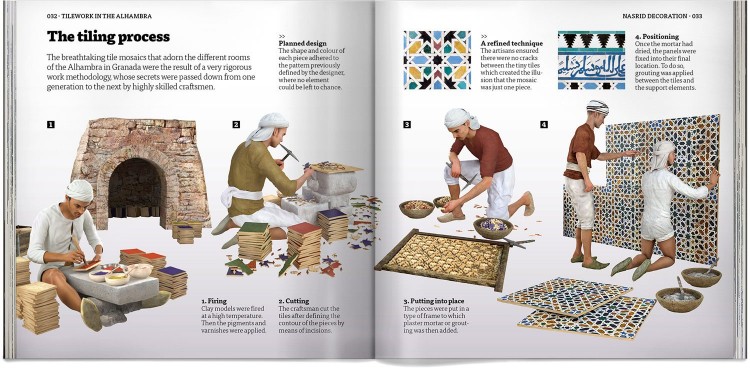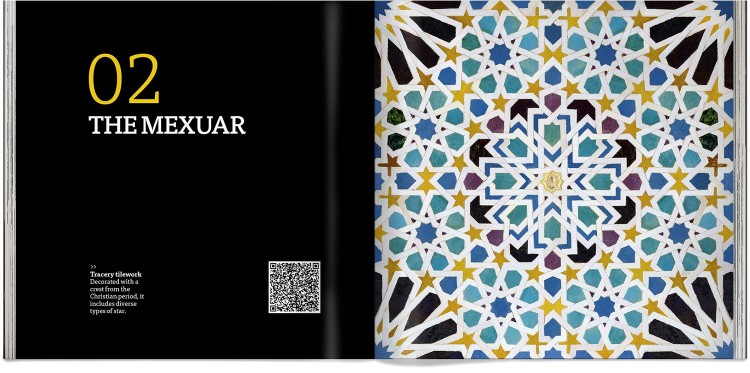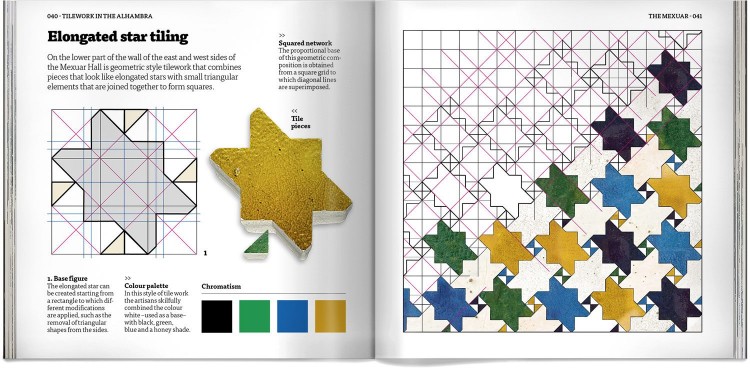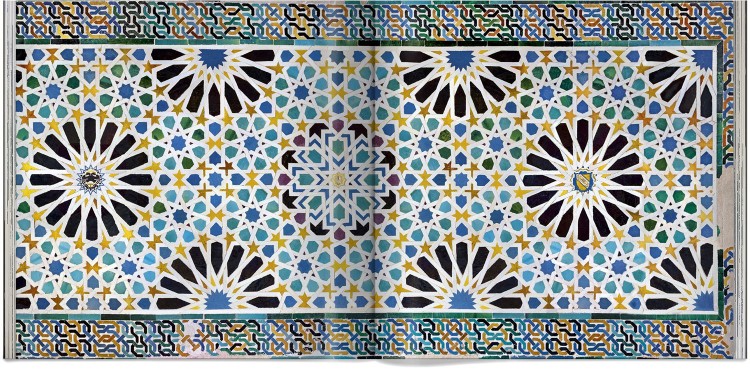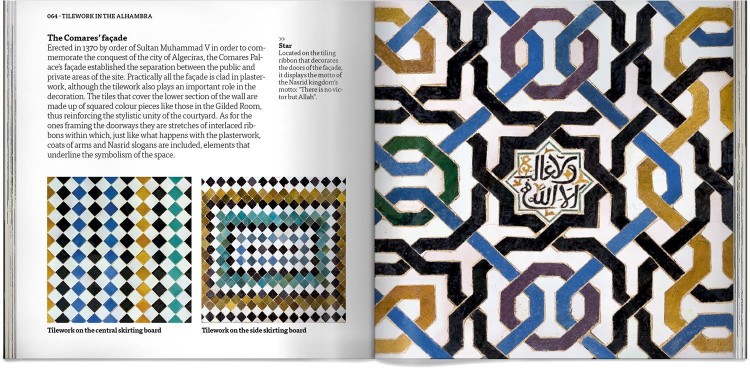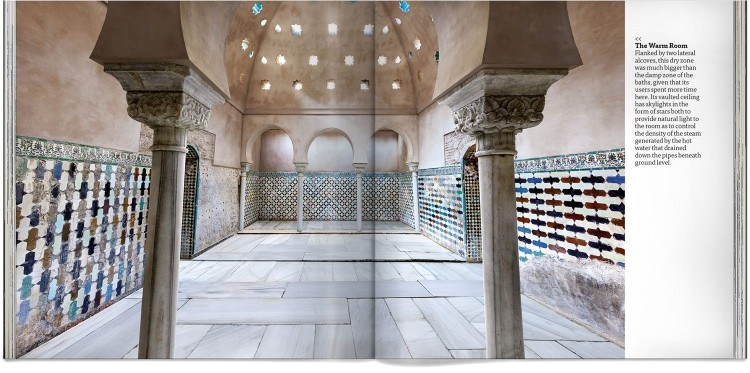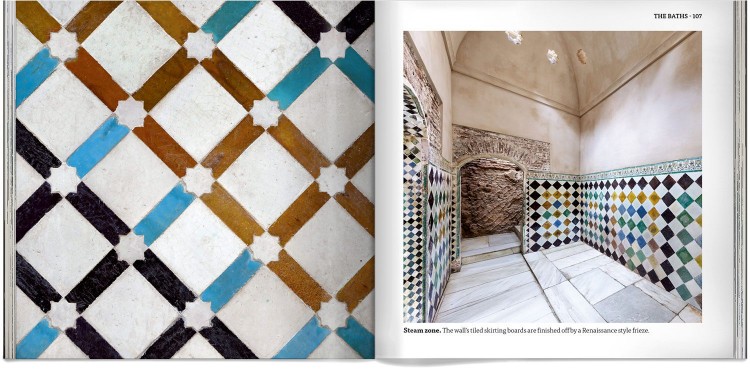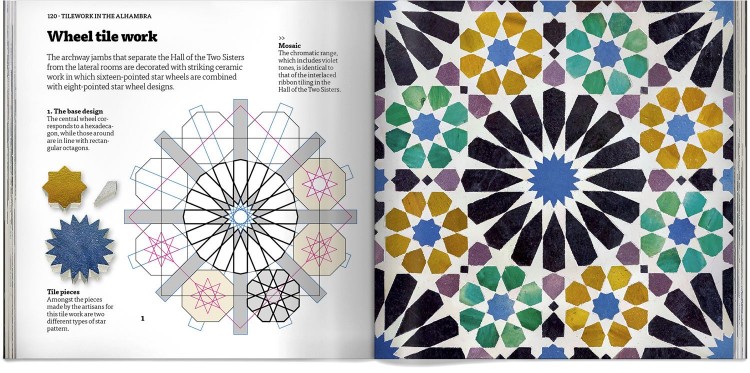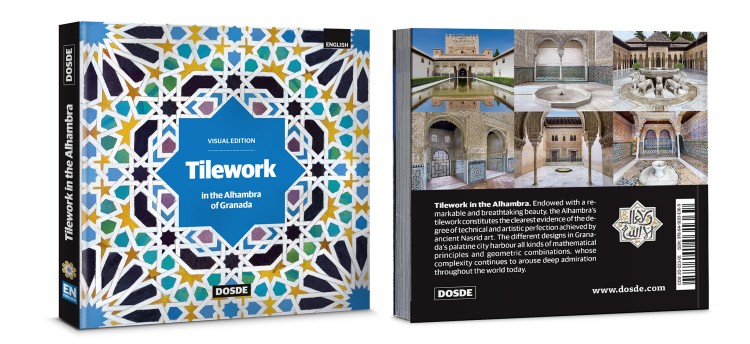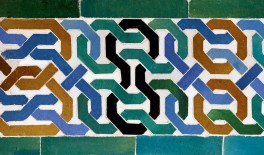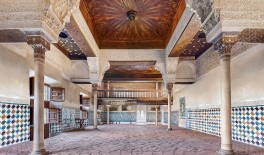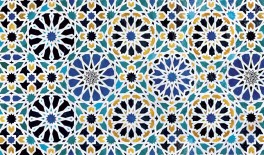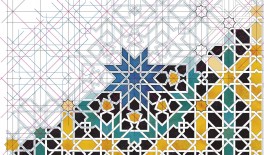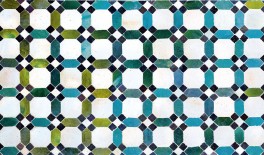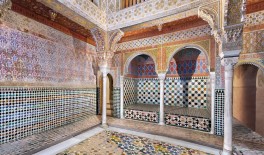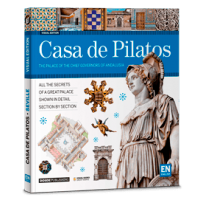Tilework in the Alhambra of Granada
RETURN
About the book Tilework in the Alhambra
This book devoted to the tiles of the Alhambra shows the complexity and beauty of Nasrid decorative art. The Alhambra's walls boast some of the most valuable tilework in history, and this book is a compilation of photographs, drawings and diagrams that explore in a detailed way the manufacturing process of Granadian ceramic work.
Structured around different chapters, the book explores each one of the spaces inside the Alhambra of Granada, amongst which include the Mexuar, the Comares Palace, the baths, the Lion Palace –where the Court of the Lions is–, the towers and the Partal. Likewise the initial chapter introduces the origins of the art of tilework, analysing the different techniques and geometrical principles that Nasrid craftsmen used in order to carry out their compositions.
This book published by Dosde gathers together the different tile patterns of the Alhambra by means of more than 250 high quality and informative pictures. The photos included in this book are unique and exclusive, carried out exclusively for this magnificent and didactic book. It is one of our Alhambra of Granada books that would interest all art and architecture lovers, as well as all those that would like to have an excellent souvenir of the Nasrid monument and the fascinating world of Andalusian tilework.
Structured around different chapters, the book explores each one of the spaces inside the Alhambra of Granada, amongst which include the Mexuar, the Comares Palace, the baths, the Lion Palace –where the Court of the Lions is–, the towers and the Partal. Likewise the initial chapter introduces the origins of the art of tilework, analysing the different techniques and geometrical principles that Nasrid craftsmen used in order to carry out their compositions.
This book published by Dosde gathers together the different tile patterns of the Alhambra by means of more than 250 high quality and informative pictures. The photos included in this book are unique and exclusive, carried out exclusively for this magnificent and didactic book. It is one of our Alhambra of Granada books that would interest all art and architecture lovers, as well as all those that would like to have an excellent souvenir of the Nasrid monument and the fascinating world of Andalusian tilework.
Visual Edition
Tilework in the Alhambra of Granada
It includes exclusive content
Multilanguage: Available in 8 languages
Made with environmentally friendly paper
More than 140 photos and 3D illustrations
About the book Tilework in the Alhambra
This book devoted to the tiles of the Alhambra shows the complexity and beauty of Nasrid decorative art. The Alhambra's walls boast some of the most valuable tilework in history, and this book is a compilation of photographs, drawings and diagrams that explore in a detailed way the manufacturing process of Granadian ceramic work.
Structured around different chapters, the book explores each one of the spaces inside the Alhambra of Granada, amongst which include the Mexuar, the Comares Palace, the baths, the Lion Palace –where the Court of the Lions is–, the towers and the Partal. Likewise the initial chapter introduces the origins of the art of tilework, analysing the different techniques and geometrical principles that Nasrid craftsmen used in order to carry out their compositions.
This book published by Dosde gathers together the different tile patterns of the Alhambra by means of more than 250 high quality and informative pictures. The photos included in this book are unique and exclusive, carried out exclusively for this magnificent and didactic book. It is one of our Alhambra of Granada books that would interest all art and architecture lovers, as well as all those that would like to have an excellent souvenir of the Nasrid monument and the fascinating world of Andalusian tilework.
Structured around different chapters, the book explores each one of the spaces inside the Alhambra of Granada, amongst which include the Mexuar, the Comares Palace, the baths, the Lion Palace –where the Court of the Lions is–, the towers and the Partal. Likewise the initial chapter introduces the origins of the art of tilework, analysing the different techniques and geometrical principles that Nasrid craftsmen used in order to carry out their compositions.
This book published by Dosde gathers together the different tile patterns of the Alhambra by means of more than 250 high quality and informative pictures. The photos included in this book are unique and exclusive, carried out exclusively for this magnificent and didactic book. It is one of our Alhambra of Granada books that would interest all art and architecture lovers, as well as all those that would like to have an excellent souvenir of the Nasrid monument and the fascinating world of Andalusian tilework.
No reviews yet.
Additional Information
- Additional Information
- Subtitle: No
- Weight (g): 275
- Binding: Paperback with flaps
- Size (cm): 14,5 x 14,5
- Author: Dosde
- Pages: 0
- Edition: Visual Edition
The tiles of the Alhambra
Endowed with a remarkable and breathtaking beauty, the Alhambra’s tiles constitute the clearest evidence of the degree of technical and artistic perfection achieved by ancient Nasrid art. The different designs in Granada’s palatine city harbour all kinds of mathematical principles and geometric combinations, whose complexity continues to arouse deep admiration throughout the world today.
In order to decorate their ceramic work, Granadan craftsmen used various techniques that were long established in the Islamic world, such as the dry rope (cuerda seca) technique and the use of green-manganese and gilded earthenware, a complex method that created a metallic glaze varnish based on the use of copper and silver pigments and with which some of the most valuable ceramic pieces of the Nasrid period were manufactured.
The breathtaking tiles of the Alhambra in Granada were the result of a very rigorous work methodology, whose secrets were passed down from one generation to the next by highly skilled craftsmen. The shape and colour of each piece adhered to the pattern previously defined by the designer, where no element could be left to chance. Clay models were fired at a high temperature. Then the pigments and varnishes were applied. The craftsman cut the tiles after defining the contour of the pieces by means of incisions. The pieces were put in a type of frame to which plaster mortar or grouting was then added. Once the mortar had dried, the panels were fixed into their final location.
The complexity of the tilework demonstrates the aesthetic sensitivity with which the Alhambra was built. This completely artisanal process, still used today by Arab tilework specialists, provides unique, breathtaking beauty to the Nasrid palaces and to spaces such as the Court of the Lions, in which ceramic decoration plays a fundamental role.
Granadan ceramic work
In Muslim art, ceramic work has always occupied a special place, so it is therefore not surprising that the Nasrids became real experts in the treatment of this material. Nasrid ceramic production was basically divided between pottery work for domestic use, which ranged from the creation of everyday ornamental pitchers to crockery as well as numerous objects used for the storage and cooking of food, and for architectonic application, with a focus on the use of polychrome tiles used for wall coverage, like those employed in the mosaics of the Alhambra.In order to decorate their ceramic work, Granadan craftsmen used various techniques that were long established in the Islamic world, such as the dry rope (cuerda seca) technique and the use of green-manganese and gilded earthenware, a complex method that created a metallic glaze varnish based on the use of copper and silver pigments and with which some of the most valuable ceramic pieces of the Nasrid period were manufactured.
The tiling process
Developed by Muslims in their attempt to emulate Greco-Roman and Byzantine mosaics, the tiling technique consists of cutting pieces of monochrome glazed ceramic using pliers or nippers to obtain fragments of different sizes and geometric shapes –called aliceres in Spanish– which are then put into place like a jigsaw one next to another, following a previously established pattern. The origin of this type of decoration is somewhat uncertain, though in the 10th century it had already taken root in North Africa.The breathtaking tiles of the Alhambra in Granada were the result of a very rigorous work methodology, whose secrets were passed down from one generation to the next by highly skilled craftsmen. The shape and colour of each piece adhered to the pattern previously defined by the designer, where no element could be left to chance. Clay models were fired at a high temperature. Then the pigments and varnishes were applied. The craftsman cut the tiles after defining the contour of the pieces by means of incisions. The pieces were put in a type of frame to which plaster mortar or grouting was then added. Once the mortar had dried, the panels were fixed into their final location.
The complexity of the tilework demonstrates the aesthetic sensitivity with which the Alhambra was built. This completely artisanal process, still used today by Arab tilework specialists, provides unique, breathtaking beauty to the Nasrid palaces and to spaces such as the Court of the Lions, in which ceramic decoration plays a fundamental role.

